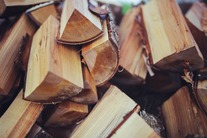In this Issue:
 American
hardwood lumber exports in 2016 were up 10% from 2015, totaling over $2.26
billion to 131 countries. The top 30
export destinations accounted for 97% of total exports, with China, Canada,
Vietnam, Mexico, and the United Kingdom representing the top 1–5
respectively. In 2016, red oak, white
oak, ash, yellow poplar, and walnut were the top 1–5 species respectively and
accounted for 78% of all hardwood lumber exports.
American
hardwood log exports in 2016 were up 5% from 2015, totaling $718 million to 116
countries. The top 30 export
destinations accounted for 98% of total exports, with China, Canada, Vietnam,
Japan, and Italy representing the top 1–5 respectively. In 2016, red oak, white oak, beech, birch,
and ash were the top 1–5 species respectively and accounted for 52% of all
hardwood log exports. To read more, click here.
|
 Recent turmoil in the European Union (EU) has not affected U.S. hardwood exports according to the American Hardwood Export Council European Market Report – November/December 2016. The United Kingdom, the largest importer of American hardwood in both value and quantity, has remained the “most important European market for American hardwoods” despite Brexit, and is expected to close 2016 at a record level of 106,000 m3. Though exports to Italy and Spain have declined in the last year, exports to the United Kingdom, Germany, Portugal, and Ireland have increased and kept Europe as the number one importer of American hardwood. Exports to Ireland, a country also affected by Brexit, has seen increased demand for U.S. hardwoods due to increased housing construction in the country. The new developments set to take place in Europe in 2017 will show a rise in demand for U.S. hardwood and thus positively affect the U.S. hardwood export economy. To view the full Dec. 2016 report, click here. For the full Jan. 2017 report, click here.
|
(Summary provided by the
American Hardwood Export Council)
In
early February the EU accepted a “System Approach” to control Emerald Ash Borer
(EAB) in U.S. ash. The system approach
combines debarking and kiln drying and places a strict limit on the amount of
residual bark or cambium but does not require that all boards be square
edged. The new requirements came into
effect immediately on publication of the “Implementing Decision” in the EU
Official Journal on February 3, 2017. It
is likely that it will take the Animal and Plant Health Inspection Service
(APHIS) approximately two months from that time to put in place the new procedures,
although there is some uncertainty about timing of the internal
authorization process due to personnel changes under the new U.S. administration.
Although
technically already in force, plant health authorities in some EU member states
may allow a period of transition before implementing the new requirements. The
UK Forestry Commission has already informed us that material on the water or
currently being issued with an APHIS phyto will be allowed to enter the UK
under the existing rules for Pest-Free Areas for a short period, the length of
which has yet to be determined but will be announced in their next newsletter.
Businesses currently preparing consignments
of ash for the EU and who are dependent on a phyto declaring Pest Free Area
origin are strongly advised to seek an assurance from the relevant plant health
authority in the destination country that it will be accepted in advance of
shipment.
Implementation
of the system approach is expected to be managed by the National Hardwood
Lumberman Association (NHLA) through an adaptation of their existing KD
certification program working under contract to APHIS. APHIS has already been
working on wording and terms of a Memorandum of Understanding and contract with NHLA for operation of
the system approach.
The
requirements for the U.S. system approach are the same as those already
established for ash imported from Canada (as this was the only way to ensure EU
agreement without yet another round of lengthy consultations). The requirements
include the following: all sawn wood is produced from debarked round wood; residual bark is
allowed but must be either less than 3 cm in width (regardless of length) or,
if greater than 3 cm in width, have total surface area of less than 50 cm2; the
wood is heated through its profile to at least 71OC for at least 1,200 minutes
with a moisture content not exceeding 10%; and the wood is dried following
industrial drying schedules of at least two-week duration.
The
new procedures require that the kilning facility is approved and audited (at
least once per month) by APHIS or an agency approved by APHIS (in this case
NHLA), that each bundle of wood visibly displays both a bundle number and a
label with the words "HT-KD" or "Heat Treated-Kiln Dried," and that the wood is
inspected by APHIS or an agency officially approved by APHIS, and that it is
accompanied by a phytosanitary certificate issued by APHIS certifying freedom
from EAB and other harmful organisms after inspection.
EU
recognition of the U.S. system approach is provisional and will be reviewed in
June 2018 subject to an audit by the EC to assess and oversee the various processes
involved in the U.S.
To view the
Commission Implementing Decision (EU) 2017/204 of February 3, 2017, from the
Official Journal of the European Union click here.
 Hardwood sales to Mexico have declined recently due to the devaluation
of the Mexican peso in comparison to the US dollar. Though certain variations
of U.S. hardwood exports saw decreased growth towards the end of 2016, Red Oak
lumber and Cherry lumber saw gains of 3% and 37% respectively due to increased
demand in Mexico. Most notably are exports of Hickory lumber to Mexico, which
have increased dramatically due to the building of a new hotel chain. The U.S.
has maintained a strong relationship with the Mexican hardwood import market
through the annual furniture design competition and attending ExpHotel and
TecnoMueble trade shows held in Mexico. The upward trend towards the end of
2016 and the events planned in 2017 point to continued upward growth of the American
hardwood export market in Mexico. To
view the full report click here.
|
 According to the American Hardwood Export Council, 2016 was a record year for U.S. hardwood exports to Southeast Asia and Greater China, with total exports up 19% from 2015. The worldwide value of U.S. hardwood exports increased by 7% from 2015, accounting for 55.2% of all global U.S. hardwood exports. Exports of hardwood lumber and logs to Greater China from the U.S. increased 22.5% and 29.1% respectively, while veneer exports shrunk in the region. Red oak, ash, and white oak are the most popular species. China’s 2017 economic motto, “seeking progress while maintaining stability,” promises continued growth of U.S. hardwood exports. Southeast Asia’s hardwood import market overall was in decline for most of 2016, though an upturn occurred towards the end of the year in Indonesia, Malaysia, and Thailand. Depreciation of Chinese currency to the U.S. dollar and BREXIT and other EU elections will be issues to the entire global market in 2017, but experts still expect hardwood profits to continue. Leaders in the U.S. and Southeast Asia and Greater China regions are optimistic about their trading relations, and have multiple events planned throughout 2017, such as furniture shows in Vietnam and Singapore and the annual Taipei Building Show in Taiwan. All of these factors will contribute to continued upward growth in the U.S. hardwood export market. To view the full reports click here.
|
 The year 2016 was a poor year for American hardwood lumber and veneer exports to the Middle East and Africa, demonstrating the biggest decline in 15 years. Construction in the Middle East has picked up pace in the past three years, with the United Arab Emirates acting as a hub for both for the trade of wood products as well as joinery, and furniture manufacturing. Exports to both Australia and New Zealand increased in 2016, and was the best year yet for American hardwood lumber exports. The continued strength of the US dollar against the Australian dollar has made American hardwoods less affordable in the last 2–3 years. The prevailing species to New Zealand was white oak, while the Australian market had a greater demand for ash and walnut. American hardwood lumber exports to India were haphazard with little sign of settling into a steady pattern. The United States is among the top ten countries for hardwood imports to India, yet in 2016, India was ranked 51st and 17th as an export destination for American hardwood lumber and logs respectively. India lumber and log exports accounted for 0.05% and 0.3% of the total American hardwood lumber and log exports respectively. Two issues might offer opportunities for American hardwood lumber exports in the future. India insists on methyl bromide fumigation for imported logs. As methyl bromide is almost banned globally, log shippers and buyers are finding it difficult to get products through Indian Customs. Also, sheesham (Dalbergia sisoo) a locally grown species and mainstay of the Indian wood industry has been listed by Convention on International Trade in Endangered Species of Wild Fauna and Flora (CITES). To view the full report click here.
|
 The
United States is among the top ten countries for hardwood imports to India. As one of the world’s fastest developing
emerging markets, recent shifts in the housing market and policy changes made
by the Indian government to create better infrastructure in the country have
increased demand for hardwoods. The largest hardwood demanding industries in
India include the construction industry, the joinery industry, and the hardwood
consumption industry (such as flooring, doors, and windows). The "Make in
India," "Start-up India," and "Stand-up India" campaigns have also contributed
to recent booms in manufacturing that have increased the need for foreign
woods. Indian tariffs and import regulations have hindered U.S. exports slightly.
India’s hardwood demand is expected to increase to from 58 million in 2005 to
153 million cubic meters by 2020 and imports are expected to “fill the gap”
left by the unchanging domestic supply.
To view the full report click here.
|
U.S. Export Duties on Canadian Lumber to Cause Market Chaos and Soaring Prices
The second quarter of 2017 is expected to be chaotic for the softwood lumber trade across North America as the U.S. implements a 25% export duty on Canadian Softwood. The position of the U.S. is to alleviate alleged unfair trade practices with Canada, its largest competitor. These duties will cause lumber prices to rise in 2017 and possibly climb continuously over the next five years. Coastal Canadian mills may be most severely impacted and see temporary closures or a severe drop in production as markets move to lower-cost species and products. European exporters may begin to enter the U.S. softwood lumber market and to fill the “supply” gap expected from the reduction in Canadian imports and the attractive higher prices. Asian markets could be disrupted as Canadian mills seek to sell surplus overseas. The stage is set for a tumultuous 2017 in the softwood lumber market. For more information, visit click here.
Please be aware
that a sophisticated email scam referred to by the FBI as Business Email
Compromise (BEC) has been targeting U.S. businesses making international
shipments. This scam occurs when an email is sent from a fake account claiming
to be from a U.S. company and requests the wire payment be rerouted to another
bank account. Once the wire is sent, this money is not able to be recovered. An
AHEC member was impersonated using this scam last week and their customer lost
a substantial amount of money. Fortunately this matter has been resolved but
the FBI warns of increasing prevalence of this scam.
In order to
prevent this sort of scam from happening to you or your customer, please be
cognizant of any red flags during the payment correspondence. If you notice any
of the following, proceed with caution.
- non-company
standard email address (using @yahoo, @gmail.com, or other generic email when
previously you were dealing with someone using an @company-name domain)
- misspelled
email address (sometimes using a capital “i” instead of a lowercase “L,” etc.)
- emails
supposedly coming from the US with extremely poor grammar and misspelled words
suggesting you click on a web link to download invoice, log in, etc.
- file
attachments that end in .exe or other non-document file types (this is a
program, NEVER open an attachment ending in .exe that someone sends you over
email)
- bank
information is different from previous orders or the purchase order/contract
The FBI has
provided guidance on how to protect yourself from this sort of online scam.
When in doubt, forward the email to someone else at the company you know and
confirm the new email address. If you
would like to report suspected BEC or other phishing activity you can reach out
to your local FBI field office at www.fbi.gov.
To view guidance click here.
|
Interzum Furniture Expo
May 16-19 I Cologne, Germany
Qingdao International Furniture and Woodworking Machinery
Exhibition
May 25-28 I Qingdao, Shandong, China
AHEC Greater China Southeast Asia Convention***
June 22-23 I Qingdao, Shandong, China
Sylva Wood Shanghai 2017***
June 26-28 I Shanghai, China
100% Design South Africa
(AHEC Seed to Seat SA project
exhibition)
August 5-9 I Johannesburg, South Africa
VIFA WOODMAC Vietnam 2017
August 23-25 I Binh Duong, Vietnam
FMC Premium 2017***
Sept. 12-15 I Shanghai, China
iFMAC & WoodMAC 2017
Sept. 17 I Jakarta, Indonesia
Vietnamwood***
Oct. 18-21 I Ho Chi Minh City, Vietnam
Taipei International Building Construction & Decoration
Exhibition
Dec. 17 I Taipei, Taiwan
***AHEC Pavilion
Follow us on Twitter for valuable insider information about upcoming events, links, and news.
Become a Fan of the International Marketing Program on Facebook
Get in touch and stay informed with program updates on LinkedIn
 Donna LaCourt
lacourtd2@michigan.gov
517-614-5518
|